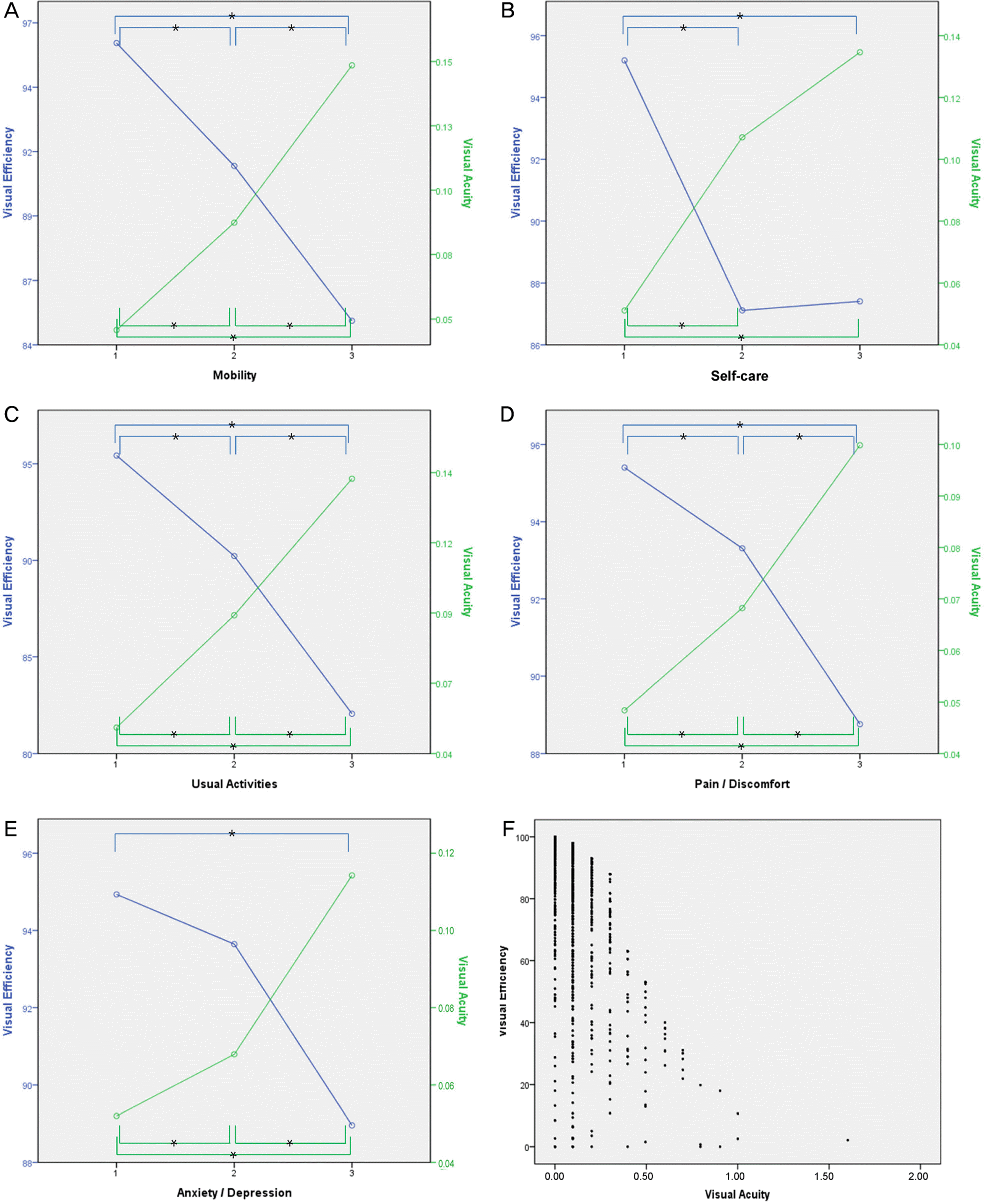Abstract
Purpose
To analyze the association of visual efficiency and quality of life using data from the fifth Korea National Health and Nutrition Examination Survey (KNHANES V).
Methods
The present study included 5,244 glaucoma or glaucoma suspect subjects who completed a visual acuity test, visual field test and health-related questionnaire from the KNHANES V. Visual efficiency was calculated using best corrected visual acuity and visual field test. Quality of life was assessed with EuroQoL 5D (EQ-5D). Visual efficiency was compared with best corrected vision of the better eye to evaluate the relationship with quality of life. One-way analysis of variance (ANOVA) and partial correlations analysis were used to analyze the associations between factors.
Results
Both visual efficiency and best corrected visual acuity of the better eye were significantly different with all EQ-5D parameters (p < 0.005). After controlling for age, gender, income, education, spouse and house ownership, visual efficiency showed a positive correlation coefficient of +0.040 (p = 0.006) with the quality of life and the best corrected visual acuity of the better eye showed negative correlation coefficient of −0.044 (p = 0.002) with the quality of life.
Go to : 
References
1. Hwang HB, Yoon MJ. 2013 Geriatric Statistics [Internet]. Daejeon: Statistics Korea;p. c2013. [cited. 2013. 9. 30.] Available from:. http://kostat.go.kr.
2. Feng CS, Yi K. Research on the quality of life of glaucoma patients. J Korean Ophthalmol Soc. 2014; 55:1868–77.

3. Lee JY, Cho HK, Kee C. Assessment of the vision-specific quality of life using binocular esterman visual field in glaucoma patients. J Korean Ophthalmol Soc. 2013; 54:1567–72.

4. Mangione CM, Phillips RS, Lawrence MG, et al. Improved visual function and attenuation of declines in health-related quality of life after cataract extraction. Arch Ophthalmol. 1994; 112:1419–25.

5. Rim HT, Lee DM, Chung EJ. Visual acuity and quality of life: KNHANES IV. J Korean Ophthalmol Soc. 2013; 54:46–52.

6. McBride DE. Injury of the eye, disability evaluation and principles of treatment of compensable injuries. 6th ed. Philadelphia: Lippincott;1968. p. 465–79.
7. Rabin R, de Charro F. EQ-5D: a measure of health status from the EuroQol Group. Ann Med. 2001; 33:337–43.
8. Nam HS, Kim KY, Kwon SS. Research report for estimated weight for Quality of Life Survey (EQ-5D). Cheongju: Korea Centers for Disease Control and Prevention. 2007.
9. Klein BE, Klein R, Lee KE, Cruickshanks KJ. Performance-based and self-assessed measures of visual function as related to history of falls, hip fractures, and measured gait time. The Beaver Dam Eye Study. Ophthalmology. 1998; 105:160–4.
10. Klein BE, Moss SE, Klein R, et al. Associations of visual function with physical outcomes and limitations 5 years later in an older population: the Beaver Dam eye study. Ophthalmology. 2003; 110:644–50.
11. Kulkarni KM, Mayer JR, Lorenzana LL, et al. Visual field staging systems in glaucoma and the activities of daily living. Am J Ophthalmol. 2012; 154:445–51.e3.

12. Medeiros FA, Gracitelli CP, Boer ER, et al. Longitudinal changes in quality of life and rates of progressive visual field loss in glaucoma patients. Ophthalmology. 2015; 122:293–301.

13. Skalicky SE, Goldberg I. Are we ready to assess quality of life routinely in our glaucoma patients? Bull Soc Belge Ophtalmol. 2010; (315):5–7.
14. Sullivan PW, Ghushchyan V. Preference-based EQ-5D index scores for chronic conditions in the United States. Med Decis Making. 2006; 26:410–20.

Go to : 
 | Figure 1.Mean visual efficiency and best corrected visual acuity on EQ −5D questionnaire and scatter plot between visual efficiency and best corrected visual acuity of the better eye. (A) Mobility. (B) Self-care. (C) Usual activities. (D) Anxiety/depression. (E) Pain discomfort. (F) Scatter plot. ‘1’ means no problem in performance, ‘2’ means mild disability or disturbance, and ‘3’ means moderate to severe disability or disturbance. EQ −5D = EuroQoL 5D. *Statistically significant, left scale is visual efficiency in percentage, right scale is log MAR of best corrected visual acuity of the better eye. |
Table 1.
Sociodemographic characteristics in study population
Table 2.
Partial correlation analysis between visual efficiency and best corrected visual acuity and EQ-5D index when adjusted with age, sex, personal and family income level, educational status, occupational status, existence of spouse
| EQ-5D index | Correlation coefficient | p-value |
|---|---|---|
| Visual efficiency | 0.040 | 0.006 |
| BCVA | −0.044 | 0.002 |




 PDF
PDF ePub
ePub Citation
Citation Print
Print


 XML Download
XML Download